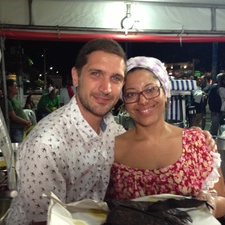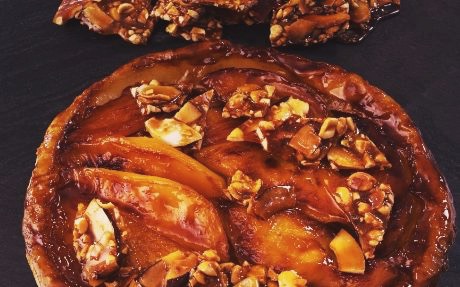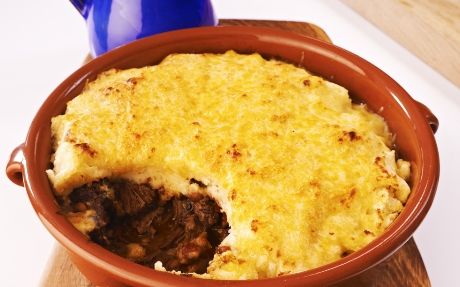Oxtail and Watercress with Black Pudding Polenta
Andy Bates
So I met back with my guide in Salvador, William. I have enjoyed uncovering another aspect to street food and tasting such ancient recipes rooted with religious influence. William asked me how adventurous I was with my street food. A bit wry, I accept, and I'm taken to another street food speciality of Salvador, the passarinha. Jussara is known to have one of the best stalls in town and is especially famous for her passarinha, which is beef spleen and entrails. William tells me that Jussara works on her mother's stall and has a lot to live up to as her mum is one of Salvador's queens of Candomble food. The stall has been in their family for 60 years, and their food regularly gets voted as best in the town. The process is really long because you need to take all the skin off the entrails, marinate the meat, season it and fry it in palm oil.
Beef Spleen.
Jussara's passarinha.
Jussara & I
This was my first time trying beef spleen, and I am hooked! And it's the use of offal that got me excited for this new dish.
My Oxtail and Watercress with Black Pudding Polenta
INGREDIENTS
- 1 large onion, peeled and roughly chopped
- 2 cloves garlic, peeled
- Olive oil
- Sea salt
- 2kg oxtail, cut into thick slices
- 250ml red wine
- 500ml beef stock
- 400g tin chopped tomatoes
- 1 bay leaf
- Dash of Worcestershire sauce
- 2 large bunches watercress, roughly chopped
- Small bunch chives, finely chopped
- 3 tomatoes, peeled, deseeded and finely chopped
FOR THE GARNISH:
- 600ml chicken stock
- 150g quick-cook polenta
- 50g unsalted butter
- 50ml double cream
- 200g morcilla or black pudding, cut into 1cm cubes
METHOD
Purée the onion and garlic in a food processor with a dash of olive oil and a good pinch of salt. Tip into a bowl with the oxtail and toss to coat. Cover and refrigerate overnight.
Heat a little olive oil in a large, heavy-based casserole over medium-high heat. Drain the oxtail, reserving the marinade, and wipe off any excess. Fry the oxtail in batches until golden brown all over then transfer to a plate with a slotted spoon. Deglaze the pan with the wine then add the stock, tinned tomatoes, bay leaf, Worcestershire sauce and reserved marinade. Bring to the boil and return the oxtail to the pan then reduce the heat to a simmer. Cover with a lid and cook gently for 3 hours until tender, topping up with a little more stock during cooking if necessary.
Carefully remove the oxtail from the pan with a slotted spoon then increase the heat and reduce the sauce for a few minutes until thickened. Add the watercress then return the oxtail to the pan. Reheat gently then season to taste.
Meanwhile make the polenta. Bring the stock to the boil in a saucepan then quickly whisk in the polenta (make sure you whisk continuously to prevent the polenta from turning lumpy). Turn the heat down and keep whisking for 2 minutes or until the polenta has thickened and starts to pull away from the sides of the pan. Remove from the heat, stir through the butter, cream and morcilla and season to taste.
Serve the oxtail with the polenta and garnish with chopped chives and tomato concasse.

















